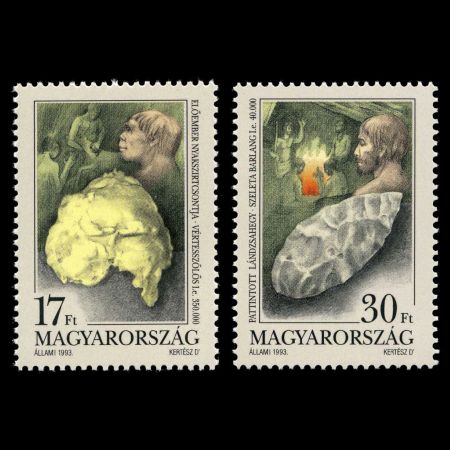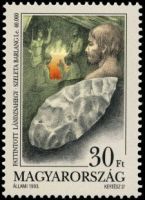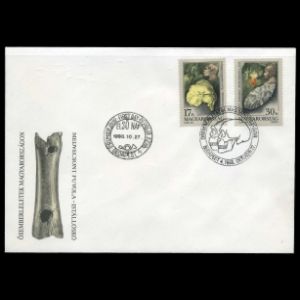Hungary 1993 "Finds of prehistoric Settlements"
| Issue Date | 27.10.1993 |
| ID | Michel: 4266-4267, Scott: 3410-3411, Stanley Gibbons: 4163-4164, Yvert et Tellier: 3433-3434, Category: An |
| Design | Kertesz Danel |
| Stamps in set | 2 |
| Value | 17 F., Homo erectus skull roof and reconstruction,
BC 350 000, found at Vertesszolos 30 F., Stone tool, Cro Magnon reconstruction, cave Szeleta BC 40 000 is shown |
| Emission/Type | commemorative |
| Issue places | Budapest |
| Size (width x height) | 28mm x 40mm |
| Layout | |
| Products | FDC x 1 |
| Paper | no watermark |
| Perforation | 13.25 x 13 |
| Print Technique | Offset lithography |
| Printed by | State Printing Works (ANY Biztonsági Nyomda Nyrt), Budapest |
| Quantity | 700.000 sets |
| Issuing Authority | Magyar Post |

On October 27th, 1993, the Post Authority of Hungary issued a set of two stamps dedicated to some artifacts of prehistoric humans found in the country.
 |
 |
| Hungarian National Museum, Hungary 1954, MiNr.: 1384, Scott: 1085. It is a prt of set of 3 values "5 years of Constitution". |
He was a late Homo erectus, somewhere between Homo erectus and Homo sapiens. Only a part of the occipital bone was found. He lived about 350,000 years ago.
The archaeological site was discovered by Marton Pecsi in 1962; the occipital bone was found three years later during a dig led by Laszlo Vertes.
Since it was found on August 21, the name day of Samuel, it was named Samu (Hungarian version of Sam). Two child teeth were also found. Samu was able to use stone tools and fire.
Replica of the remains can be viewed in the local Vertesszolos Museum. Original fossils are on show in the Hungarian National Museum in Budapest.
 |
In the hillside above Miskolc-Felsohamor, the Seleta Cave was explored by Ottokar Kadic between 1907 and 1913 at the instigation of Otto Herman who launched research into prehistoric man in Hungary.
In the cave entrance not only were many cave bear bones found but even traces of a fireplace. As the excavations continued fragments of pots and Neolithic stone tools came to light, while the earlier layers hid a total of 40 Paleolithic stone tools.
Today under strict protection, the cave evolved through the dissolving effect of a once plentiful karst spring that has since dried out. The passages are over 90 metres long in all. The cave is a temporary and permanent home to numerous endangered animal species, including both protected and strictly protected bat species. The protected cave is not developed. It can be visited at any time.
Products
| FDC | Mini Sheet | |
 |
 |
|
References

|
Acknowledgements
Many thanks to Dr. Peter Voice from Department of Geological and Environmental Sciences, Western Michigan University, for reviewing the draft page .| <prev | back to index | next> |